

Vol. 40 (Number 3) Year 2019. Page 29
Sergei Vladimirovich VOLKOV 1; Ilsur Khalilevich GARIPOV 2; Denis Mihailovich LASTOCHKIN 3; Andrey Andreevich MEDYAKOV 4; Evgeny Mihailovich ONUCHIN 5; Aleksey Petrovich OSTASHENKOV 6
Received: 17/09/2018 • Approved: 05/01/2019 • Published 28/01/2019
ABSTRACT: The present study is devoted to the consideration of approaches to evaluating the reliability of solar energy systems, taking into account the changeability of the power of solar power plants due to changes in the density of the solar energy flux. As a result, a mathematical model to evaluate the reliability of the solar energy system for power supply was developed, and the calculation of its reliability parameters for a dwelling house on the basis of a solar power plant was carried out. |
RESUMEN: El presente estudio está dedicado a la consideración de enfoques para evaluar la confiabilidad de los sistemas de energía solar, teniendo en cuenta la variabilidad de la potencia de las plantas de energía solar debido a los cambios en la densidad del flujo de energía solar. Como resultado, se desarrolló un modelo matemático para evaluar la confiabilidad del sistema de energía solar para el suministro de energía, y se llevó a cabo el cálculo de sus parámetros de confiabilidad para una vivienda sobre la base de una planta de energía solar. |
Renewable energy sources can be widely used for energy supply by rural consumers. On the one hand, this is due to the availability of renewable energy sources; on the other hand, relatively low energy consumption by agricultural consumers, as compared to industrial ones, causes the best technical and economic performance when using converters of renewable energy sources. In particular, in regions with relatively high insolation, it is promising to use solar power plants to provide the power supply for small facilities, for example, rural dwellings (Soronin, S.M., 2012). A scheme of the installation of solar power supply is shown in Fig. 1.
Figure 1
Scheme of the installation of solar power supply
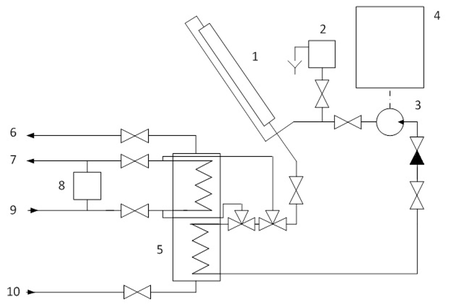
1 are solar collectors; 2 is an expansion tank;
3 is a circulating pump; 4 are photovoltaic modules;
5 is a hot water tank; 6 into a hot water supply system;
7 in a heating system; 8 is a gas heating boiler;
9 from a heating system; 10 from an aqueduct
The system of solar power supply includes photovoltaic modules, which convert solar energy into electrical one, controller, and storage batteries. The solar collector converts the energy of solar radiation into heat, which is used to heat the heat carrier circulating through the pump in a closed loop through the heat exchanger of the thermal accumulator. In the presented scheme, a thermal accumulator is used to smooth the daily fluctuations in the power of the solar energy flow. In order to ensure heating and hot water supply during a long decrease in insolation, a gas boiler is used.
When using renewable energy sources, it is necessary to take into account the changeability of the power of renewable energy flux, which makes it necessary to evaluate the reliability of power supply systems based on them. In this connection, the study of the reliability of such systems is topical.
The object of the current study is a power supply system for a rural dwelling house.
The subject of the study is the reliability of the power supply system based on the solar-power plant.
The purpose of the paper is to conduct a study of the reliability of the power supply system for a rural dwelling house on the basis of a solar power plant.
In order to meet the purpose of the study, the following tasks were set:
1. To consider methods for evaluating the reliability.
2. To carry out a simulation of the functioning of the solar energy system for energy supply.
3. To calculate the reliability parameters of the power supply system on the basis of the solar power plant.
The list of elements in the composition of solar energy systems for power supply is determined by the features of the scheme for matching the solar power plant with the consumer. It should be noted that the matching scheme should provide compensation for the changeability of the intensity of the solar energy flux. In this connection, it can be concluded that such a power supply system is characterized by features that determine the application of the system analysis method to the reliability study:
1. The power supply system is a set of elements, which, in turn, depending on the structure of the technical object can be considered as systems separately;
2. Power supply systems are characterized by the presence of integral properties, i.e. properties inherent only in the system as a whole, but not characteristic of any of its elements separately;
3. The power supply system is characterized by the presence of significant links between the elements, which makes it possible to single out the system as a complete independent object.
Analysis of literature in the field of modeling the reliability of technical systems, which also include solar energy systems for power supply, showed that in some cases it is impossible to use traditional physical experimental studies to obtain reliable results. This causes a wide use of simulation methods in the study of the reliability of technical systems in engineering practice. The purpose of the simulation is to obtain new information about the object. A characteristic feature of the methods of simulation is that it is not the object itself that is subjected to the study, but its model (mathematical) in the form of an algorithm of functioning. The model should reflect, with a certain precision, the properties and characteristics of the object that are significant in the context of the purpose of the research.
As part of the reliability study, a number of simplifications were introduced, which is due to the presence of structural elements, the values of reliability indicators of which differ significantly. In this regard, the reliability scheme has taken into account the elements that have the greatest impact on the reliability of the energy supply system as a whole. The design model is shown in Fig. 2.
Figure 2
Design model of the solar energy system for energy supply
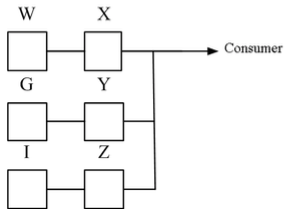
W are solar collectors; X is a circulating pump;
Y is a valve; G is a gas heating boiler;
I is a accumulator tank; Z is a valve.
Study and modeling of the reliability of the solar-energy system was carried out using the following principles:
- The energy supply system was considered as a set of interrelated elements, subsystems;
- Study of the reliability of the solar energy system for energy supply requires analysis of the properties of all structural elements, as well as the interrelations between them;
- The most promising modeling of reliability is the mathematical one at the macro level, which is due, on the one hand, to the availability of data on the reliability of individual elements of the energy supply system, and on the other hand, to the relatively simple description of the structure of the system.
Study of the reliability of the power supply system was carried out using the logical-and-probabilistic method by building a tree of failures (Billinton R., Bagen, Cui Y., 2003; Grigorieva, O.A., Krivenko, T.V., Tremyasov, V.A., 2016; Tremyasov, A., Vladimir & V. Krivenko, Tatyana., 2017). This approach allows for the recording of events that can cause a failure of the power supply system, including failures of its individual elements, as well as events that generate them.
The tree of failures was built by sequential detailing of events related to failures of the power supply system elements (Abouzahr, Imad, Ramakumar, R., 1990). When considering a power supply system based on a solar power plant, it is advisable to divide the events into two types: occurring when there is a design and off-design density of the solar energy flux.
With design insolation, events that lead to the failure of the power supply system were determined. The latter were also divided into short-term ones, in which only switching operations were needed to restore the functioning of the power supply system, and long ones, which included complex events, coincided simultaneously with the failure of one element at diagnosing or repairing the other. The occurrence of an off-design (reduction or absence of a flux of solar radiation on the receiving surface of solar collectors) was taken into account by introducing the symbol (H). It should be noted that, in addition to projected daily insolation decreases by the time of evening twilight, there are seasonal changes in insolation that are stochastic. The latter were taken into account by using the "prohibition" logical sign in the failure tree, which allows taking into account the event that occurs with a certain probability. The Q event is a restrictive condition that is a probabilistic factor. In this case, the restrictive condition is characterized by the magnitude of the conditional probability of the occurrence of an off-design insolation (q). The last parameter is determined based on the insolation data at the location of the solar energy system for energy supply by determining the time, during which there is insolation sufficient to increase the temperature of the heat carrier of the thermal battery and to provide the heating and hot water supply.
Based on the analysis of the failure tree, the failure functions can be formulated. Taking into account the generated failure functions, the following equations for calculating the failure rate were determined.
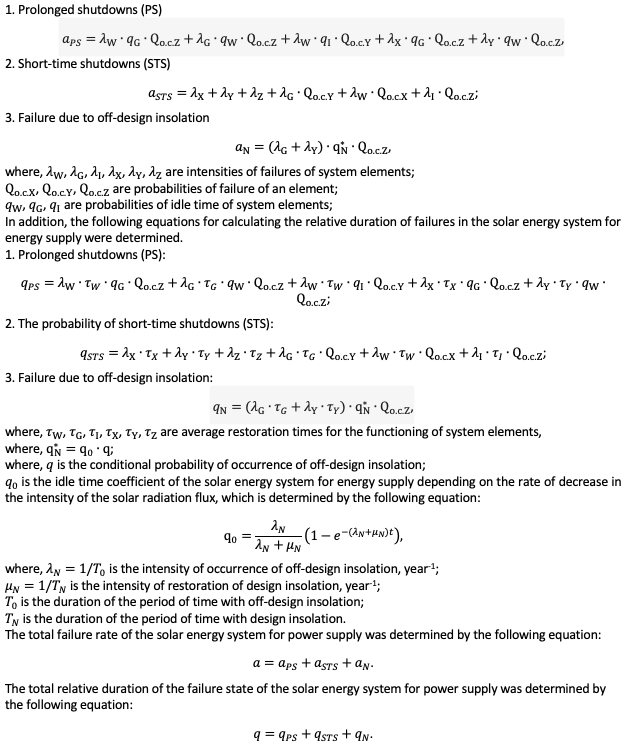
Since the calculations require data on the duration of time periods with off-design and design insolation, a calculation of heat consumption for heating, Qh, and hot water supply, Qhw, of a one-story 90 m2 dwelling building calculated for one-family of 4-5 people was carried out, and the area of solar collectors was calculated as well. Calculation of heat consumption was carried out for the climatic conditions of the Republic of Mari El, Russian Federation. Also, the share of the heat load covered by the solar energy system for power supply using the f-method was calculated (Duffie J.A., Beckman W.A., 2006). The results of the calculations are given in Table 1.
Table 1
Results of calculation of the share of heat load (f) covered by the use of solar collectors
№ |
Month |
Qh, MJ |
Qhw, MJ |
f |
f∙(Qh+Qhw), MJ |
1 |
January |
9890.21 |
3779.80 |
0.106 |
1446.961 |
2 |
February |
8287.21 |
3414.01 |
0.212 |
2484.345 |
3 |
March |
7466.29 |
3779.80 |
0.482 |
5425.613 |
4 |
April |
4681.28 |
3657.87 |
0.921 |
7680.653 |
5 |
May |
1058.38 |
3779.80 |
1.467 |
7099.876 |
6 |
June |
|
3657.87 |
1.622 |
5931.523 |
7 |
July |
|
3779.80 |
1.633 |
6171.441 |
8 |
August |
|
3779.80 |
1.572 |
5940.744 |
9 |
September |
1200.85 |
3657.87 |
1.329 |
6458.745 |
10 |
October |
5073.92 |
3779.80 |
0.705 |
6241.978 |
11 |
November |
6691.17 |
3657.87 |
0.330 |
3415.027 |
12 |
December |
8360.15 |
3779.80 |
0.134 |
1627.922 |
As a result of the analysis of the data presented in the above table, it can be concluded that the solar energy system for energy supply fully provides the heat supply of the facility in the time period from April to September. Thus, 7 months of the year the heat energy generated by the solar power plant is not enough to cover the needs for heating and hot water supply. In this case, it is possible to conditionally divide the year into two periods: the period with design insolation, when the heat supply function is provided by the solar power plant, and the period with off-design insolation. It should be noted that in reality and during the period of time from October to April a part of the monthly load is covered by the use of a solar power plant. However, in order to simplify the calculations, it was assumed that insolation in the period of time from October to April is off-design. Thus, the following data were accepted for calculating the reliability:
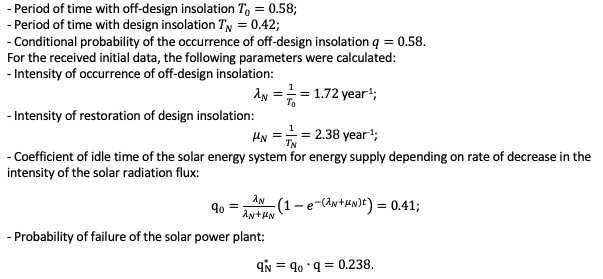
As part of the calculation, the values of the parameters characterizing the reliability of the elements of the solar energy system for energy supply were taken on. Parameter values are shown in Table 2.
Table 2
Input data for calculating the reliability
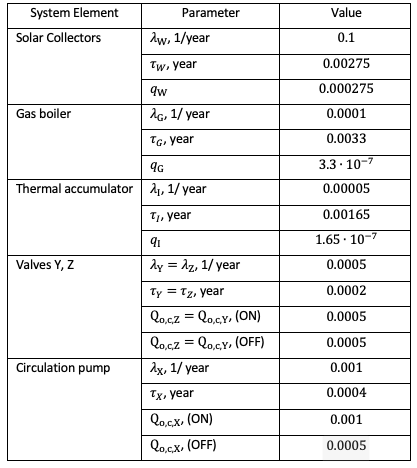
The results obtained by substituting the input data into the calculation equations are presented in Table 3.
Table 3
Results of calculating the reliability parameters of the power supply system
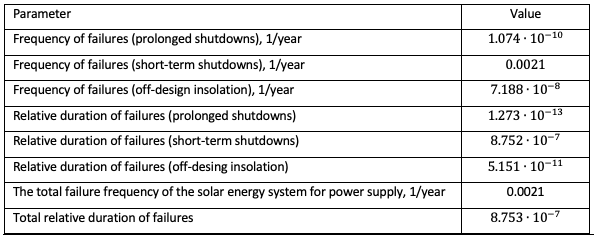
1) Study of the reliability of the solar energy system for power supply is promising to be carried out using the logical-probabilistic method by building a tree of failures. This approach allows for the recording of events that can cause a failure of the power supply system, including failures of its individual elements, as well as events that generate them. The tree of failures was built by sequential detailing of events related to failures of the power supply system and its elements.
2) The reliability of the power supply system for a dwelling house for the climatic conditions of the Republic of Mari El, Russian Federation, has been studied. The total failure rate of the solar energy system for power supply was 0.0021 1/year, the total relative duration of failures was .
1. Grigorieva, O.A., Krivenko, T.V., Tremyasov, V.A. (2016). Reliability analysis of an autonomous wind-diesel complex. St. Petersburg State Polytechnical University Journal. 45-52.
2. Abouzahr, Imad, Ramakumar, R. (1990). Loss of power supply probability of stand-alone wind electric conversion systems: A closed form solution approach. Energy Conversion, IEEE Transactions on. 5. 445-452.
3. Billinton R., Bagen, Cui Y. (2003). Reliability evaluation of small stand-alone wind energy conversion systems using a time series simulation model. IEE Proceedings - Generation, Transmission and Distribution, vol. 150, no. 1, 96-100.
4. Soronin, S.M. (2012). The formation of autonomous power supply systems of agricultural facilities based on renewable energy sources, M. S. thesis, Zernograd, 13-15.
5. Duffie J.A., Beckman W.A. (2006). Solar Engineering of Thermal Processes, Third Edition, John Wiley & Sons, 375-379.
6. Tremyasov, A., Vladimir & V. Krivenko, Tatyana. (2017). Reliability Evaluation Method of the Wind-Diesel Installation with Application of Dynamic Fault Tree. Journal of Siberian Federal University. Engineering & Technologies. 10. 414-425.
1. Mari State University, Russian Federation
2. Mari State University, Russian Federation
3. Volga State University of Technology, Russian Federation
4. Volga State University of Technology, Russian Federation
5. Volga State University of Technology, Russian Federation
6. Mari State University, Russian Federation; E-mail: eef@marsu.ru